
I purchased my Oculus Rift headset back in July 2016 and since then it has had a lot of use. Last month I started to get an intermittent issue with the HDMI disconnecting.
I assumed that it was the headset cable and so I contacted Oculus support who told me that the cables are no longer being supplied or sold unless the headset was under warranty.
I tried a different HDMI extension cable on my Rift headset and the issue was resolved so it was a problem with the extension but as I knew that other people had problems with their cables it was only a matter of time before mine failed, rendering the VR kit worthless and junk as Oculus have chosen not to support first-generation VR headset users.
I found a lot of other people who had the same headset cable issues and who are unable to get a replacement cable and so I decided to order a faulty cable from eBay to see if it is possible to repair them to give me a spare cable for the future.
The faulty cable arrived from eBay and it had several large kinks and flattened areas in its length. I connected the cable to my Oculus Rift headset and starting at the headset end of the cable, moved the cable around bending it in all directions to find the section which had a fault.
The fault was tracked down to a section around 20cm from the headset connector end and after removing the outer plastic covering and separating the wires we reconnected it to the headset and wiggled each of the exposed wires to try to recreate the blank headset problem.
Cable Overview
Inside the outer cable covering is a metal braid and shield which contains the following:
2 x USB cables, twisted pair which are green and white.
5 x shielded twisted pairs for HDMI channels with ground wire and shield in each.
5 small cables.
4 larger cables.
Your Raspberry Pi Projects Start Here
Please support the blog and our projects by buying your Raspberry Pi development boards and accessories from our online store at AB Electronics UK.
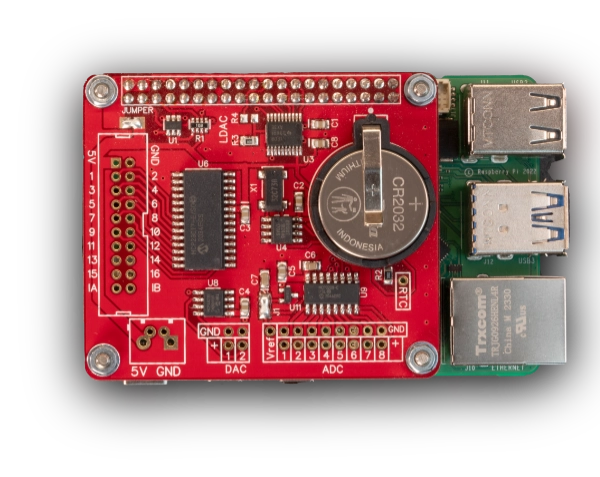
The Problem Wire(s)
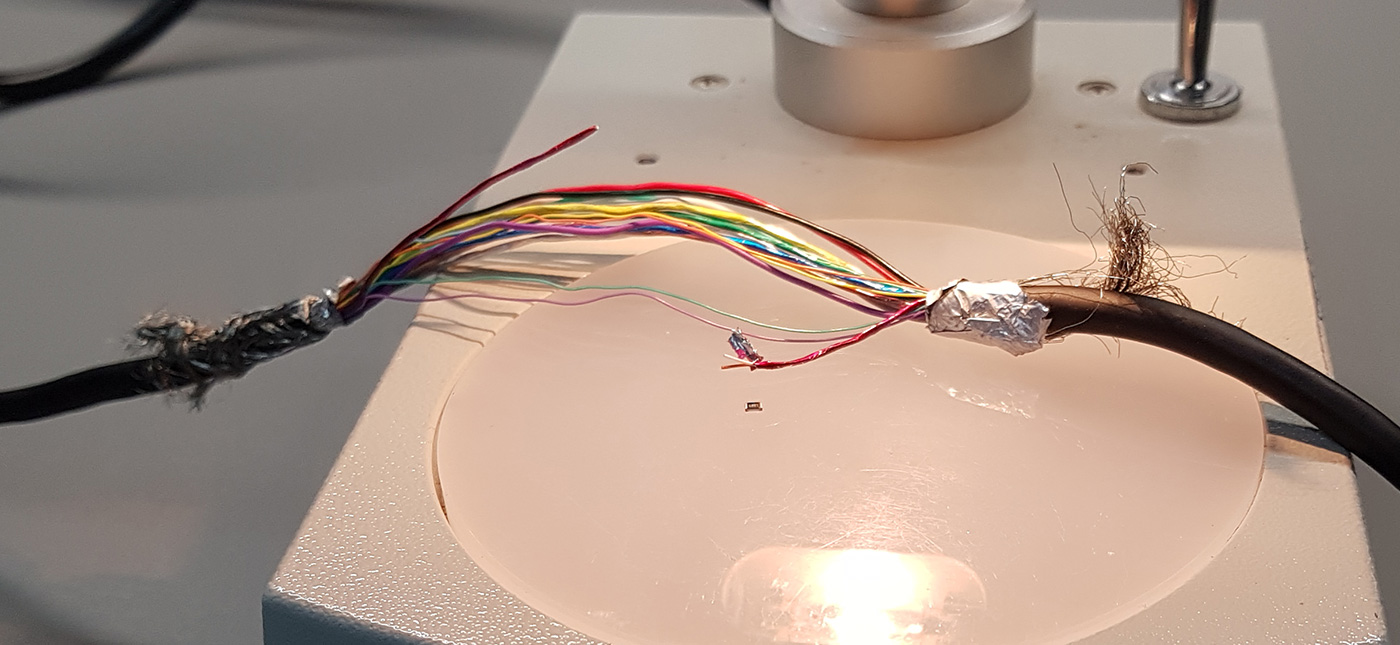
The issue was tracked down to an intermittent connection on what appeared to be a small red/silver cable and after inspection, under the microscope, it turned out to be a twin pair twisted cable with a metal shield and foil covering which appears to be one of the HDMI channels.

Using photos taken under the microscope at 20x magnification next to a known size component (0805 resistor), I was able to approximate the cable size to be:
Outer shielded sheath 0.8mm diameter.
Twisted pair inner cable 0.3mm diameter.
Twisted pair inner cable core: 0.12mm diameter.
As these are much too small for me to solder by hand and keep the tight twists in the pair of cables, I was not able to proceed any further with repairing the cable and so we decided to take the headset connector apart to see what is inside and if it would be possible to source a replacement.
Removing the plastic covering revealed a shielded metal enclosure.

Lifting the metal cover revealed a small circuit board with a second plastic cover and the cable connections sealed in a clear potting compound.
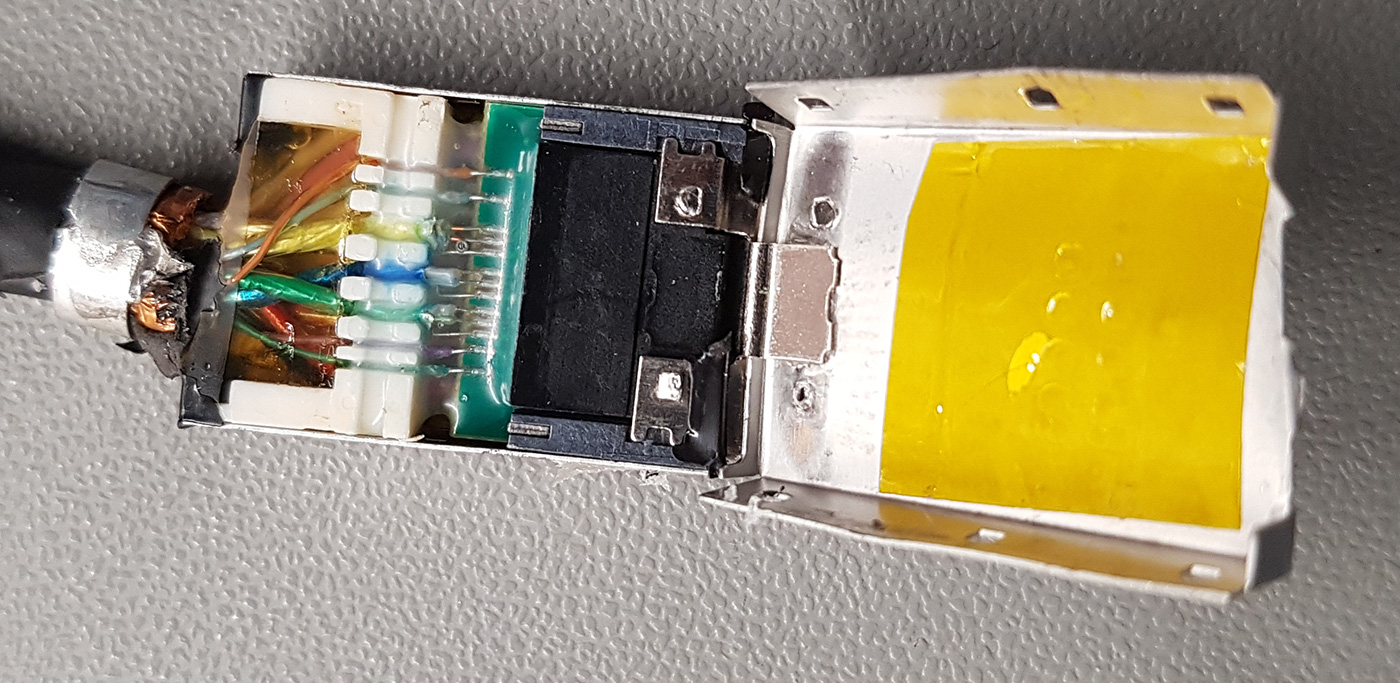
The photo below shows the very small twisted pair of HDMI cables with their three connections to the connector.

Under the other side of the connector was a very small circuit.
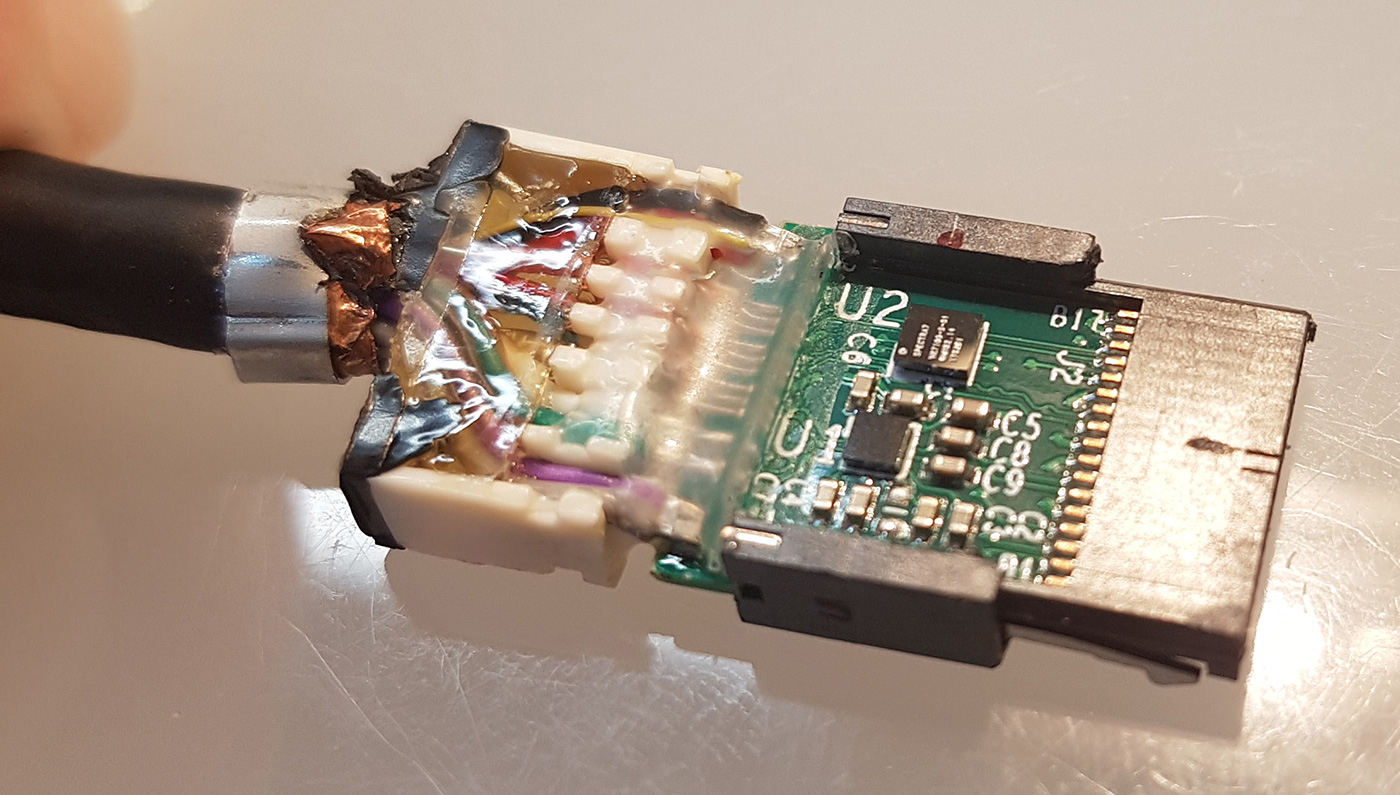
The integrated circuits are marked as:
S7
`VR7050
S01.04
G1UN86
1734MO
This is a VR7050 USB 3.0 In-Cable Equalizer from www.spectra7.com/
SPECTRA7
VR7100-S-01
QMN82.14
1732DI
This seems to be an older chip dating back to 2012 from this press release: https://www.spectra7.com/pdfs/VR7100_PressRelease_Rev_2.2.pdf which states:
“The VR7100 features patented chip technology which is optimized to deliver the video bandwidth required for a fully immersive, stereoscopic 3D experience. The chip leverages Spectra7’s patented power harvesting algorithms, eliminating the need for any external power source while delivering up to Ultra HD 4K resolution. The VR7100 is available in a miniature, ultra-low profile QFN package measuring 5mm x 5mm.”

Update: 19th Sept.
After posting a link to this post on Reddit there were numerous comments regarding my soldering skills and how easy it would be to connect wires with a thickness the same as a human hair (0.08 – 0.1mm width).
Soldering the actual cables together wouldn’t be too much of an issue with the fine tip irons we use but the problem would be insulating the twisted pair of cables and maintaining the twists thought out the length of the repairs.
With twisted pair cables, having a straight section without the twists would cause problems with the signal integrity and can introduce interference with the HDMI data rendering the repair useless.
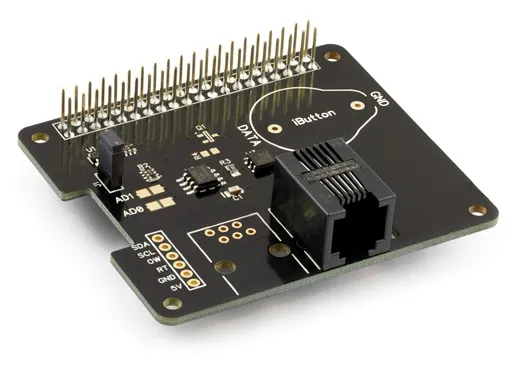
Corscaria
Im 99.99% certain that the chips in the cable can be left out if you use thicker cables. The purpose of the chips is to allow the use of thinner and thus lighter cables.
I bought a CV1 off eBay, but it didn't come with a cable. So I'm trying to find one cheap, even a broken one. I have a strict rule that i wont pay more than i paid for the CV1, which disqualifies every cable on eBay...
Rajko
Since you already opened up the cable any chance of documenting the proprietary end's pinout ?
Roman
This really sucks, mine just broke. I can't believe all the pieces are just trash now and I have to buy another vr headset. So frustrating. Thanks for the attempt
T Bastian
How about replacing the 17 pin connector on the MB and create a new cable, thicker perhaps, but sturdier??
Alexis
Thank you so much for all of the useful info here, it gave me the knowledge and confidence to try a repair of my own. My CV1 cable has been broken for months (ran over it with an office chair) and I've tried everything to get a replacement short of ordering one from eBay for $200. So emailing after emailing Oculus support again today and being told the same "we haven't made a decision about offering replacement cables" I found this article and proceeded to dismantle my Oculus cable, I figured worst case scenario is I still had a broken Oculus. It turns out that there was a hair thin baby blue wire that had been cut, so I had to melt the shielding off of both ends of the wire because when I tried to strip it the wire broke again. Since I don't own a soldering iron I twisted the two wires together and then wrap them in electrical tape. After that I wrapped that whole section of wire in electrical tape and then used two tongue depressors as splints and wrapped that entire thing in electrical tape to prevent the wires from moving and coming disconnected. I figure it might last a few months if I'm lucky and very gentle with it but it's working for now. So it turns out the cable is repairable if it is a simple wire break like mine.
Andrew McAdam
Good article. I'm about to try to attach a new USB plug to my oculus cable as someone tripped over the cable which bent the USB connecter and broke it. I've found if I clamp the USB plug with a vice I can get it to work but I want a better solution. My only worry (before cutting the cable yet) is whether the colors of the individual cables will match those in my replacement USB3 cable, there's a lot of them.
Dan
It doesn't match i don't think. your going to need a vr7050 to replace the USB portion but I don't know the pin out
Greg
Thanks for this attempt and posting the information you could get from it. I have done micro-circuit repairs before (smaller than that resistor you posted) and have an idea for you.
Why not solder a female HDMI + USB 3 connector to the Rift's proprietary connector? You would need to melt the white glue from it (heat gun on low+ scrape off glue) then trace the connections using a multimeter. Once you get the pinouts mapped it's just a matter of soldering on the female connections for the HDMI+USB3. You can then run any male to male HDMI+USB3 cable from the PC to the the headset. If the cable breaks again it's not an issue as you can buy a new HDMI/USB3 cable easily.
Luckily my CV1 cable is still fine, but if it ever goes and Oculus won't provide replacements this will be my attempt to repair it. If it fails I'm moving on to another brand as companies that do this to customers don't deserve further business.
Terry
Love the new comments.. Im working on an fix like in what Greg mentioned, using std cables for length and making a shorter rift cable like the TPCast one... Working on pinouts..
Great minds
Great minds think alike i guess. I was just talking to my son about his Oculus last week. My hdmi and USB connectors come in Thuesday from Amazon, and i am going to cut his cable short, then add the hdmi and usb connector to it. Then stiffen the short proprietary cable section, and he can buy replacement HDMI and USB cables thereafter. I also considered opening it up and changing the proprietary connectors..
Luis
Did anyone have any success trying to add HDMI and USB female connectors to the headset? Id like to try the same on a Samsung Odyssey+ which appears to have the same configuration. Thanks.
Fistula
Hi there, i got a non functioning rift for cheap and the cable was the issue. i found a kink in the wire, so inspected this area. under the shielding, a tiny tiny thin yellow wire had a kink in it, so i used a lighter to burn off that section of platic coating. and there it was. a break in the wire. i twisted it back together and put scotch tape on it to hold it in place. it worked! probably got 50 hrs of game play out of it in that state. i konw its rough, but im sure some of you more experianced folk could sort it better.
Oliver Schwarzer
Maybe we get lucky and some Chinese Company will build those Cables in the Future. Are Chinese here? Hello? Please tell your chinese Friends that you can make tons of Money with a third Party Oculus Rift CV1 HDMI+USB3 Cable.
Magitor
I get my CV1 from second hand too, started to map the connector
Sadly, the HDMI colors, USB3 coplord don't match to standards. I gonna do the homework tomorrow, and dtry to attach a new HDMI on the cable shorter.
I disassembled the HMD too, and the mainbord was scrached on my unit, and factory sealed there. As an elecitrcal engineer, this bothers me more, than the crap cable quality. I am so glad, that I didn't pruchased yet in full price Oculus products, because this, and handling the customers is merely a bad joke.
Dale Marlow
Has anyone cut the wires and rewired at points that still transmit power? Say 12 inches below the headset connector and 12 inches above the split. It may look ugly but would it work, at least until Quest gets back in stock.
Greg
Magitor, don't bother trying to match up the colors with HDMI or USB3 standards. They customized the cable and it is very unlikely they followed any standard color scheme. You need to trace the cables from the headset back to where it connects to the PC ends. You can use a multimeter or check the color bands on each end (if possible) to map out the pins on each side.
Also, do not bother trying to bypass the Spectra7 chipsets (keep them in there) as they are needed as a "repeater" for the signals considering the cable length. Make sure you use a HDMI 2.0 or higher cable for the replacement. I'm also not sure if Oculus programmers put anything in their software to check that the Spectra7 chipset is there in use (unlikely) but keeping the Spectra7 chipsets installed should resolve that matter.
In theory, this should all work once mapped and properly soldered. It's a shame Oculus is STILL not doing anything about this when they could be making a ton of money from this and keeping customers. The new buyers of their products don't know that this is going on. Sadly, Oculus just doesn't care which is why my next 4 headsets (for my family) will not be an Oculus product.
Magitor
Hi Greg, I learned a lot from disassembling the cables. The USB3 also have a few ic.
For exact tracing, the USB must be stripped also.
Next time i try to cut te lenght super short, and attach the new HDMI first, if not work, then figure out how to bypass the whole "craple".
Oculus is a crappy company, I won't recommend to nobody, merely a joke this situation. Only luck I spend like 100 bucks on this project. But for full price, I definitely throw it whit the company window.
Yves
Hi there, i have the same Problem with a Rift i have bought on Ebay.
But i don‘t be able to repair my cable.
If anybody can help me, i‘m afraight.
Harima Kenji
Hello greetings from Spain, thanks to this post I managed to repair the cable, if the problem is the error of hdmi the solution is to cut and solder the braided cables,, red, blue, yellow and green, which have 2 cables inside, you need a soldering iron very fine and magnifying glasses or microscope
Chris
I'll just leave these pictures I took of an HMD / HDMI connector here in case it helps anyone. Still working on repairing a different cable, currently getting no errors in the Oculus software, it shows connected and no HDMI connection error, but only getting the orange light on the headset, haven't had any luck figuring out whats missing to make it change to white.
https://imgur.com/gallery/IaJkGOp
Isma
Hi, I have also had problems with my cable. I'm going to try to repair it. I have ordered several pieces to try to create a standard connector with HDMI 2.0 and USB 3.0. The idea is to cut the cable about 15 cm from the connector of the glasses and connect two female USB and HDMI connectors to use normal cables. At the other end of the original cable place a couple more females.
Of course the first thing to do is determine each pin on the original cable. If someone has tried and has information it will be well received.
Nomen
35 years ago I desperately needed for my Sincalir Spectrum a flexible Centronix printer cable. I needed for this parallel interface about 15 wires (STB, ACK, Busy, D0-D7, PE and some GND wires - there are more signals, but they are for a home computer irrelevant). But at this time there was behind the iron curtain simply no usable cable available :( Eventually I found by chance lots of used antitank missile wire on a military firing range :) It was about 1mm thick and consisted of three thinner, insulated copper wires. It was no problem to push five of them through a 6 mm transparent spaghetti tube and an elegant, thin and flexible - but very resistant centronix cable was ready :)
It works well until now ...
Ian Crosby
There are 4m cables available from Amazon for £26 - a 1m loss is manageable, surely?
Greg
My cable hasn't died yet but I've come across this post on reddit that might be of interest to a few people here. Apparently the OP of this thread has taken the time to map out the connections on each end of the CV1 cable. He seems to have done what I suggested here, which is to keep the Spectra 7 chipset and replace the ends on both sides with female connectors so you can plug any HDMI + USB3 cable for replacements. There is mention of "cable tuning" in the thread, however that shouldn't be an issue as a replacement cable would be thicker and the Spectra 7 chipset should work fine with that as long as what has been patched in is shielded. Only downside would be a bulkier cable but at least the CV1 headset would work. The OP hasn't released the schematics or a video yet, but this may be something to keep your eye on if you can weld once the helpful information is released.
Here is the link to the post:
https://www.reddit.com/r/oculus/comments/irlw01/i_have_done_an_end_to_end_schematic_map_of_the/
Darren
Hello,
I am looking at producing a replacement cable (5 meter with braided nylon cable) for this unit. If youre interested, please follow this reddit thread.
https://www.reddit.com/r/oculus/comments/jrbte3/oculus_rift_cv1_cable_replacement_kit_newly/
Thanks!
Anon
Don't let OP's post discourage you to attempt to fix your cable.
With a bit of patience, it's totally doable ;-)
I repaired mine yesterday, one of the hdmi wire had snapped off.
I cut a piece of wire, soldered one end, put a shrink tube on it, solder the other end and put a shrink tube on it. Double secured it with some glue, wrapped it in new shielding (aluminium foil works) and electrical tape around everything.
Works like before, no notable interference
Anon
I did it! I fixed a break in my wire. (three cut wires) Turns out the wires didn't need the shielding (at least in a certain spot/certain wire). I was able to solder the three wires together and add heat shrink tubing without too much trouble. This took me only an hour.
Fabian
Hi, I have the same problem.
I discovered the cable and can see two slightly bent wires (yellow and orange).
Could this be the problem?
Can I repair them?
Thank you!
https://ibb.co/Wy5PgjC
DenDev
I think the end of this post is just to discourage others to repair their legacy Rifts, my Rift's cable got broken last week, an i was looking for an help in internet to fix it with myself, and i found this post, but yeah this discourage me a little bit, but i have no choice, its now or never, so i cut every core in the cable and solder it, and it works!!!!! and regarding to taping issues, i didn't use electrical tapes because its elastic, means it will move over time, which could cut the core wire unintentionally, so rather i use some masking tapes and apply it gently on the wires, regarding to how long the straight part should be, i recommend you to have less than 1 centimeter, it works on me too, and for wire continuity testing, i use a layer of aluminum , put it on the connector of the cable and attach a multimeter probe on it, and then another one for the wire that you need to be tested out. Regarding to the strength of the cable, i made the naked wire that sorrounds all of the thin wires be shorter than all wires sorrounds by it. Here are some pictures of my progress, and yeah im sorry i got no time to record my progress while doing it. I hope this helps.
https://ibb.co/2tWP56S
https://ibb.co/Y33KqsS
https://ibb.co/QpgkXbX
Dragos
I have just attempted to repair the cable at the connector end and I failed but my problem wasn't soldering the tiny wires was actually the big wires ripping the pads of the pcb even though I tried to keep everything fixed while soldering. So the lesson for others is the your better off fixing the cable at the break rather then at the connector.
REMO
Hi, great post and recommendations. I've been struggling with Oculus to get a replacement cable under warranty for 2 months (purchased only last Christmas) with many bot responses and diversions of driver updates when we've actually used a cable from a friend and everything works fine - can we get a cable please. Nope. (btw agree with Greg, now way they can be supported further based on how they support customers - well said) Regardless, just a couple of responses from giving up on them altogether and splicing. I had a idea to splice in using either an RJ45 (The rift S has 8 wires as well but don't think I would do more than I need. My concern is whether or not the stripping would occur correctly as some wires are thinner guage than ethernet. I've also seen phone connectors from ideal that can do up to 3 connections with a single connector. Like to get thoughts on these ideas.
DenDen
Hi Remo, from what i have done before, you could rejoin the thick cores of the rift cable with other types of core like cat5 wire, but not the thinner ones, i have tried it so many times to splice in a thin core for rift cable but i only succeeded one, after that the headset failed to respond so i just reconnect the rift cable.
UPDATE : after 3 months of playing with my repaired Rift, it is still working! I could even play movement intensive games like Population:One, however the other parts of the system are distintegrating such as the controllers and the fabrics of the headset, but it will be just a quick fix.
david
I have been using TPCast for a while now, but the video stream couldn't keep up with the frame rate for the new ed, so I have gone back to a cable, I have used a 4M 8K hdmi cable and a USB3 high speed rated cable and plugged these between the PC and the TPCast harness ( it breaks out the HDMI & USB at the headset ), the video quality difference is staggering, even over the original oculus cable. The downside is that the two cables are quite thick and heavy, but can be replaced for £15.
Tajin
Just finished my repair and it seems to work fine.
I've cut out the faulty part of the cable and soldered the ends back together.
Needless to say, it is quite fiddly and takes a lot of patience but it's certainly doable.
Do yourself a favour and buy some shrink tubes for isolation, 1mm ones worked well for me.
N8
My USB 3.0 plug that goes into my computer has broken off and cannot find it anymore has anyone found a solution to splice another 3.0 plug onto it or anything I am desperately trying to figure this stuff it feels like I'm going to have a brain aneurysm before I figure it out
parsecn
Thank you for taking the time to publish your journey at repair attempt. The detailed photos and information is excellent, albeit discouraging as it would be great to self-repair. For anyone who has stumbled on this page, please take a moment to vote at Oculus user voice "Please continue selling Rift CV1 spares for a reasonable time" An email address and name is all that is required to vote.